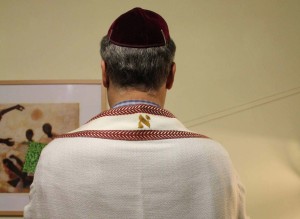 My tallit is one of my most personal and precious Jewish objects. It is what I wrap around me when I step into prayer – intimate, I-Thou encounter with God. When I had one handwoven for me by the wonderful Amy Smith at Blue Feet Studio, I wanted to personalise it so that it could have special meaning for me. But I also wanted to remind myself of what the tallit means within the Jewish community.
My tallit is one of my most personal and precious Jewish objects. It is what I wrap around me when I step into prayer – intimate, I-Thou encounter with God. When I had one handwoven for me by the wonderful Amy Smith at Blue Feet Studio, I wanted to personalise it so that it could have special meaning for me. But I also wanted to remind myself of what the tallit means within the Jewish community.
First, we don’t have to wear a tallit but … there is a commandment – within the Shema text – to wear and see tzitzit ‘fringes’ as a reminder of the precepts in the Shema (just like knots in a handkerchief). The tallit provides a garment on which the tzitzit can be tied.
Second, there is number symbolism (gematria) associated with the tallit:
- The numerical equivalent of the word tzitzit is 600, and the 5 knots plus 8 strings (found on each corner of the tallit) add up to 13, so the total is 613, the traditional number of mitzvot (‘commandments’) we must follow within the disciplined practice and observance of Judaism (think of this as a symbolic rather than a literal number).
- The windings of thread (7-8-11-13) between the sequence of knots at each corner make the number equivalent of YHVH, the mystical, unpronounceable name of God (7+8=15=YH, 11=VH); 13 makes E-CH-a-D, meaning ‘one’ – so the windings represent the core statement of monotheism ‘God is One’, as stated in the first line of the Shema.
Third, there does not have to be a neck band – atarah (‘crown’) – but it helps, to know which way up the garment is. Some people choose to have the blessing for wearing tzitzit placed on the atarah (which is helpful if you only go to synagogue twice a year, and can’t remember the blessing!). The traditional words for putting on the tallit are: Baruch atah adonai eloheinu melach ha-olam asher kid’shanu b’mitzvotav v’tzivanu lahitateif batzitzit (Blessed are You, Lord our God, Soveriegn of the universes, who has sanctified us with His commandments, and commanded us to wrap ourselves in tzitzit). More recently, people have taken to choosing a text that is personally meaningful to them to go on the atarah.
My personalised atarah: a single aleph
There is a midrash (story) of the revelation at Sinai. Some say that the people heard only the first two commandments directly, others say they only heard the first word, anokhi (‘I’). And then, wonderfully, there is another teaching (from Rabbi Mendl Torum of Rymanov) that says that they heard only the first letter, the aleph, which, of course, is silent. Lawrence Kushner, in ‘The Book of Miracles’, wrote his own version of what Rabbi Mendl said: “Aleph makes a tiny, little sound that is the beginning of every sound. Stop! That is the aleph. God made the voice of aleph so quiet that if you made any other noise you wouldn’t be able to hear it.” What better preparation for prayer, davenen, or donning the tallit, than that moment of turning inwards to listen for what the 15th century Indian mystical poet Kabir called the ‘breath within the breath’, and what I call the ‘voice within the voice’. So the single letter aleph on the atarah, for me, says it all, and is in tune with what I believe is at the heart of my work as a musician, as a davenner and singer of ritual music, and teacher – to listen for revelation, for truth, by leaning into the Great Silence.